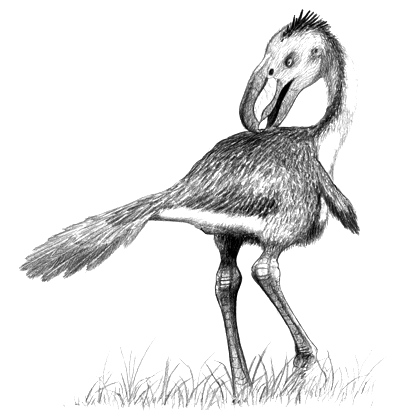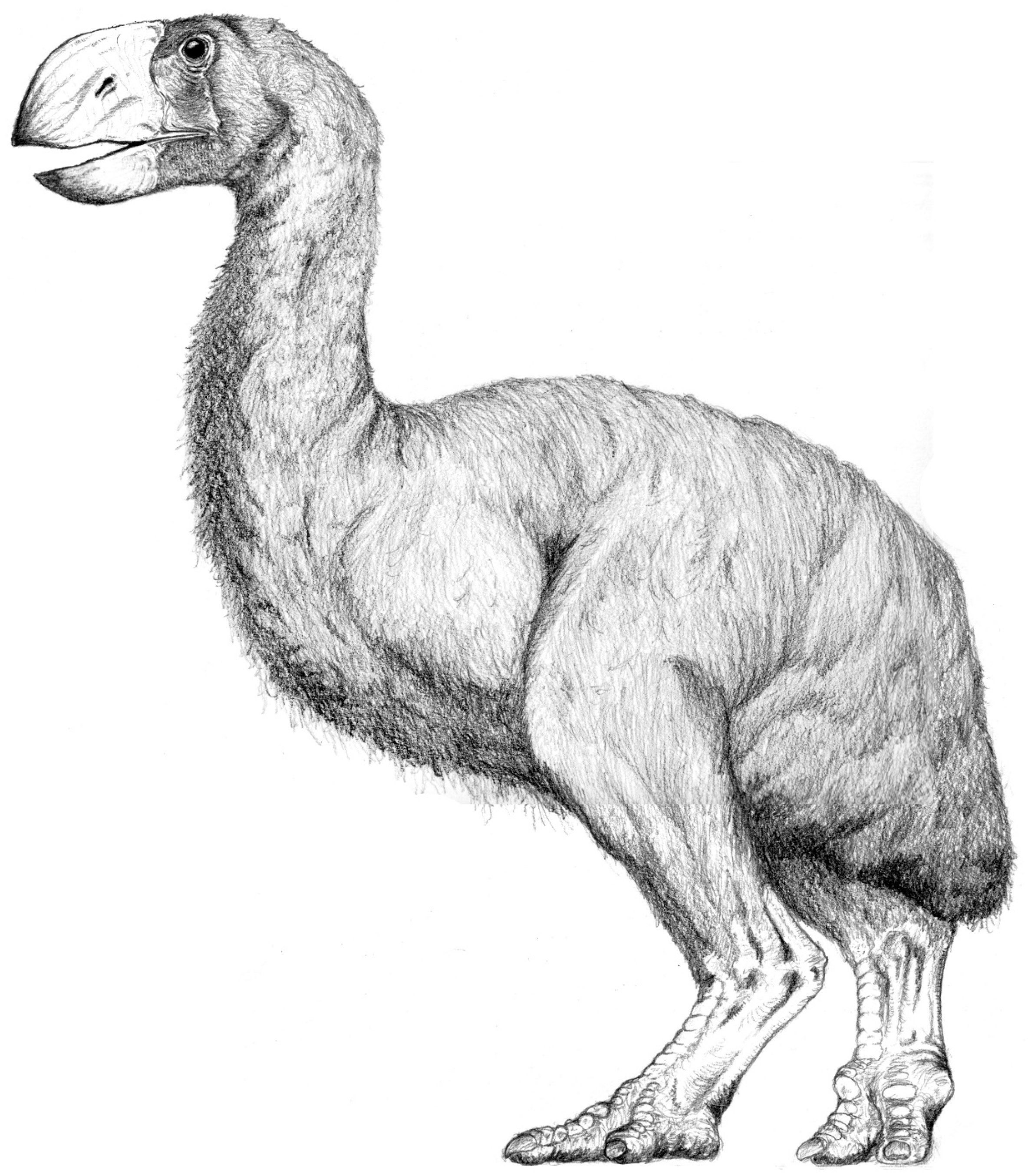|
Devincenzia
''Devincenzia'' is an extinct genus of giant flightless predatory birds in the family Phorusrhacidae or "terror birds" that lived during the Early Miocene (Deseadan) Fray Bentos Formation of Uruguay and Late Miocene (Huayquerian) Ituzaingó Formation to Early Pliocene (Montehermosan) of Argentina. The type species ''D. pozzi'' was formerly known as ''Onactornis pozzi''.''Devincenzia'' at .org It stood about tall, making it one of the largest Phorusrhacids and carnivorous birds known. Etymology The generic name ''Devincenzia'' comes from Uruguayan museum director and zoologist Garibaldi Devincenzi (1882-1943) and the specific name of ''D. gallinali'' ...[...More Info...] [...Related Items...] OR: [Wikipedia] [Google] [Baidu] |
Kelenken
''Kelenken'' is a genus of phorusrhacid ("terror bird"), an extinct group of large, predatory birds, which lived in what is now Argentina in the middle Miocene about 15 million years ago. The only known specimen was discovered by high school student Guillermo Aguirre-Zabala in Comallo, in the region of Patagonia, and was made the holotype of the new genus and species ''Kelenken guillermoi'' in 2007. The genus name references a spirit in Tehuelche mythology, and the specific name honors the discoverer. The holotype consists of one of the most complete skulls known of a large phorusrhacid, as well as a tarsometatarsus lower leg bone and a phalanx toe bone. The discovery of ''Kelenken'' clarified the anatomy of large phorusrhacids, as these were previously much less well known. The closest living relatives of the phorusrhacids are the seriemas. ''Kelenken'' was found to belong in the subfamily Phorusrhacinae, along with for example '' Devincenzia''. Phorusrhacids were large, ... [...More Info...] [...Related Items...] OR: [Wikipedia] [Google] [Baidu] |
Huayquerian
The Huayquerian ( es, Huayqueriense) age is a period of geologic time (9.0–6.8 Ma) within the Late Miocene epoch of the Neogene, used more specifically within the SALMA classification. It follows the Mayoan and precedes the Montehermosan age. Etymology The age is named after the Huayquerías Formation The Huayquerías Formation ( es, Formación Huayquerías) is a Late Miocene fossiliferous geological formation of the Frontal Cordillera and Cuyo Basin of Argentina. The formation crops out in the central Mendoza Province. The formation, with a m ... in the western Cuyo Basin of northwestern Argentina that was later dated to the Montehermosan. The most complete Huayquerian fauna is found in the Cerro Azul Formation, in Buenos Aires Province also referred to as Epecuén Formation. Formations Fossil content Correlations Notes and references Notes References Bibliography ;Huayquerías Formation * * ;Andalhuala Formation * ;Camacho Formation * ... [...More Info...] [...Related Items...] OR: [Wikipedia] [Google] [Baidu] |
Deseadan
The Deseadan ( es, Deseadense) age is a period of geologic time (29.0–21.0 Ma) within the Oligocene epoch of the Paleogene to the Early Miocene epoch of the Neogene, used more specifically within the SALMA classification of South America. It follows the Tinguirirican and precedes the Colhuehuapian age. Etymology The age is named after the Deseado Formation of the Deseado Massif in eastern Patagonia, Argentina. Formations Fossils Correlations The Deseadan South American land mammal age (SALMA) is equivalent to the Arikareean in the North American land mammal age (NALMA) and the Harrisonian in the 2000 version of the classification. It overlaps with the Hsandagolian of Asia and the MP 25 zone of Europe, the Waitakian and the Landon epoch Landon is a personal name of English origin that means "long hill". It is a variant of Langdon. Landon became popular in the United States in the 1990s, and by 2010 had become the 32nd most popular name for boys. [...More Info...] [...Related Items...] OR: [Wikipedia] [Google] [Baidu] |
Ituzaingó Formation
The Ituzaingó Formation ( es, Formación Ituzaingó), in older literature also described as Entre Ríos or Entrerriana Formation, is an extensive geological formation of Late Miocene (Tortonian, or Huayquerian in the SALMA classification) age in the Paraná Basin of the Corrientes, Santa Fe and Entre Ríos Provinces in Mesopotamia, northeastern Argentina.Ituzaingó Formation at .org The formation comprises mudstones, cross-bedded |
Phorusrhacidae
Phorusrhacids, colloquially known as terror birds, are an extinct clade of large carnivorous flightless birds that were one of the largest species of apex predators in South America during the Cenozoic era; their conventionally accepted temporal range covers from 62 to 0.1 million years ( Ma) ago. They ranged in height from . Their closest modern-day relatives are believed to be the seriemas. '' Titanis walleri'', one of the larger species, is known from Texas and Florida in North America. This makes the phorusrhacids the only known large South American predator to migrate north in the Great American Interchange that followed the formation of the Isthmus of Panama land bridge (the main pulse of the interchange began about 2.6 Ma ago; ''Titanis'' at 5 Ma was an early northward migrant). It was once believed that ''T. walleri'' became extinct in North America around the time of the arrival of humans, but subsequent datings of ''Titanis'' fossils provided no evidence for their s ... [...More Info...] [...Related Items...] OR: [Wikipedia] [Google] [Baidu] |
Psilopterus
''Psilopterus'' (Greek for "bare wing") is an extinct genus of phorusrhacid ("terror bird") from the Middle Oligocene to possibly the Late Pleistocene of Argentina and Uruguay. Compared to other phorusrhacids, members of the genus are both relatively gracile and diminutive, and include the smallest known species of terror bird: with the head raised ''P. bachmanni'' was in height and weighed about , while the largest members of the genus were only about . The birds resemble the modern cariama (''Cariama cristata''), except with a heavier build and considerably smaller wings. The strong morphological similarity between the claws of the predatory cariama and ''Psilopterus'', both of which are sharp, curved, and laterally compressed, may indicate they were used to strike prey. In contrast to the other, larger terror birds, Tonni and Tambussi also suggested ''Psilopterus'' could use their claws to climb trees, and could even fly, but this has been rejected in more recent literature. ... [...More Info...] [...Related Items...] OR: [Wikipedia] [Google] [Baidu] |
Phorusrhacos
''Phorusrhacos'' ( ) is an extinct genus of giant flightless terror birds that inhabited Argentina during the Miocene epoch. ''Phorusrhacos'' was one of the dominant land predators in South America at the time it existed. It is thought to have lived in woodlands and grasslands. Discovery and naming Remains are known from several localities in the Santa Cruz Formation and Monte León Formation in the Santa Cruz Province, of Argentina. Among the bones found in the strata of the Santa Cruz Formations (now considered as mainly of mid-Miocene date) was the piece of a mandible which Florentino Ameghino discovered in early 1887 and the same year at first described as that of an edentate mammal which he named ''Phorusrhacos longissimus''. The generic name is derived from Greek -φόρος, (-''phoros''), an element meaning "bearer" in word combinations, and ῥάκος, (''rhakos''), "rag" or "wrinkle", probably in reference to the wrinkled jaw surface. When the original derivati ... [...More Info...] [...Related Items...] OR: [Wikipedia] [Google] [Baidu] |
Mendoza, Argentina
Mendoza (, ), officially the City of Mendoza ( es, Ciudad de Mendoza) is the capital of the province of Mendoza in Argentina. It is located in the northern-central part of the province, in a region of foothills and high plains, on the eastern side of the Andes. As of the , Mendoza had a population of 115,041 with a metropolitan population of 1,055,679, making Greater Mendoza the fourth largest census metropolitan area in the country. Ruta Nacional 7, the major road running between Buenos Aires and Santiago, runs through Mendoza. The city is a frequent stopover for climbers on their way to Aconcagua (the highest mountain in the Western and Southern Hemispheres) and for adventure travelers interested in mountaineering, hiking, horse riding, rafting, and other sports. In the winter, skiers come to the city for easy access to the Andes. Two of the main industries of the Mendoza area are olive oil production and Argentine wine. The region around Greater Mendoza is the largest ... [...More Info...] [...Related Items...] OR: [Wikipedia] [Google] [Baidu] |
Xenarthra
Xenarthra (; from Ancient Greek ξένος, xénos, "foreign, alien" + ἄρθρον, árthron, "joint") is a major clade of placental mammals native to the Americas. There are 31 living species: the anteaters, tree sloths, and armadillos. Extinct xenarthrans include the glyptodonts, pampatheres and ground sloths. Xenarthrans originated in South America during the late Paleocene about 60 million years ago. They evolved and diversified extensively in South America during the continent's long period of isolation in the early to mid Cenozoic Era. They spread to the Antilles by the early Miocene and, starting about 3 Mya, spread to Central and North America as part of the Great American Interchange. Nearly all of the formerly abundant megafaunal xenarthrans became extinct at the end of the Pleistocene. Xenarthrans share several characteristics not present in other placental mammals, which suggest their ancestors were subterranean diggers for insects. The name Xenarthra deriv ... [...More Info...] [...Related Items...] OR: [Wikipedia] [Google] [Baidu] |
Macraucheniidae
Macraucheniidae is a family in the extinct South American ungulate order Litopterna, that resembled various camelids. The reduced nasal bones of their skulls was originally suggested to have housed a small proboscis, similar to that of the saiga antelope. However, one study suggested that they were openings for large moose-like nostrils. Conversely, prehistoric pictographs by indigenous people seems to depict animals interpreted as macraucheniids with trunks. Their hooves were similar to those of rhinoceroses today, with a simple ankle joint and three digits on each foot. Thus, they may have been capable of rapid directional change when running away from predators, such as large phorusrhacid terror birds, sparassodont metatherians, giant short-faced bears (''Arctotherium)'' and saber-toothed cats (''Smilodon''). Macraucheniids probably lived in large herds to gain protection against these predators, as well as to facilitate finding mates for reproduction. The family Macrauch ... [...More Info...] [...Related Items...] OR: [Wikipedia] [Google] [Baidu] |
Brontornis
''Brontornis'' is an extinct genus of giant bird that inhabited Argentina during the Early to Middle Miocene. Its taxonomic position is highly controversial, with authors alternatively considering it to be a cariamiform, typically a phorusrhacid (terror bird) or an anserimorph. Taxonomy The first fossils of ''Brontornis burmeisteri'' were described by paleontologists Francisco Moreno and Alcides Mercerart in 1891, the fossils being a left femur, tibiotarsus, fibula, and tarsometatarsus all from the same individual found in the Lower- Middle Miocene strata of the Santa Cruz Formation in Santa Cruz Province, Argentina.Brodkorb, P. (1967). ''Catalogue of fossil birds: part 3 (Ralliformes, Ichthyornithiformes, Charadriiformes)''. University of Florida. In the same paper, two distal tibiotarsi from the same area were referred to ''Brontornis'' as well.Moreno, F. P., & Mercerat, A. (1891). ''Catálogo de los pájaros fósiles de la República Argentina conservados en el Museo de L ... [...More Info...] [...Related Items...] OR: [Wikipedia] [Google] [Baidu] |
Pierce Brodkorb
William Pierce Brodkorb (September 29, 1908, Chicago – July 18, 1992, Gainesville, Florida) was an American ornithologist and paleontologist. Interested in birds since childhood, he was taught to prepare birds at the age of 16. Later, he received the opportunity to work as a staff technician in the Ornithology Division of the Field Museum. He entered the University of Michigan in 1933 and obtained his PhD degree in 1936. Subsequently, he became an assistant curator of birds at the Museum of Zoology in Michigan until 1946. In 1946, he accepted a professorate in the Department of Zoology at the University of Florida in Gainesville, a position he held until his retirement in 1989. His doctoral students include Glen E. Woolfenden. From the 1950s, Brodkorb built up a huge collection of bird fossils from the Miocene, the Pliocene, and the Pleistocene of Florida, which included 12,500 skeletons from 129 families, and is on display at the Florida Museum of Natural History, part of ... [...More Info...] [...Related Items...] OR: [Wikipedia] [Google] [Baidu] |







_(cropped).jpg)

